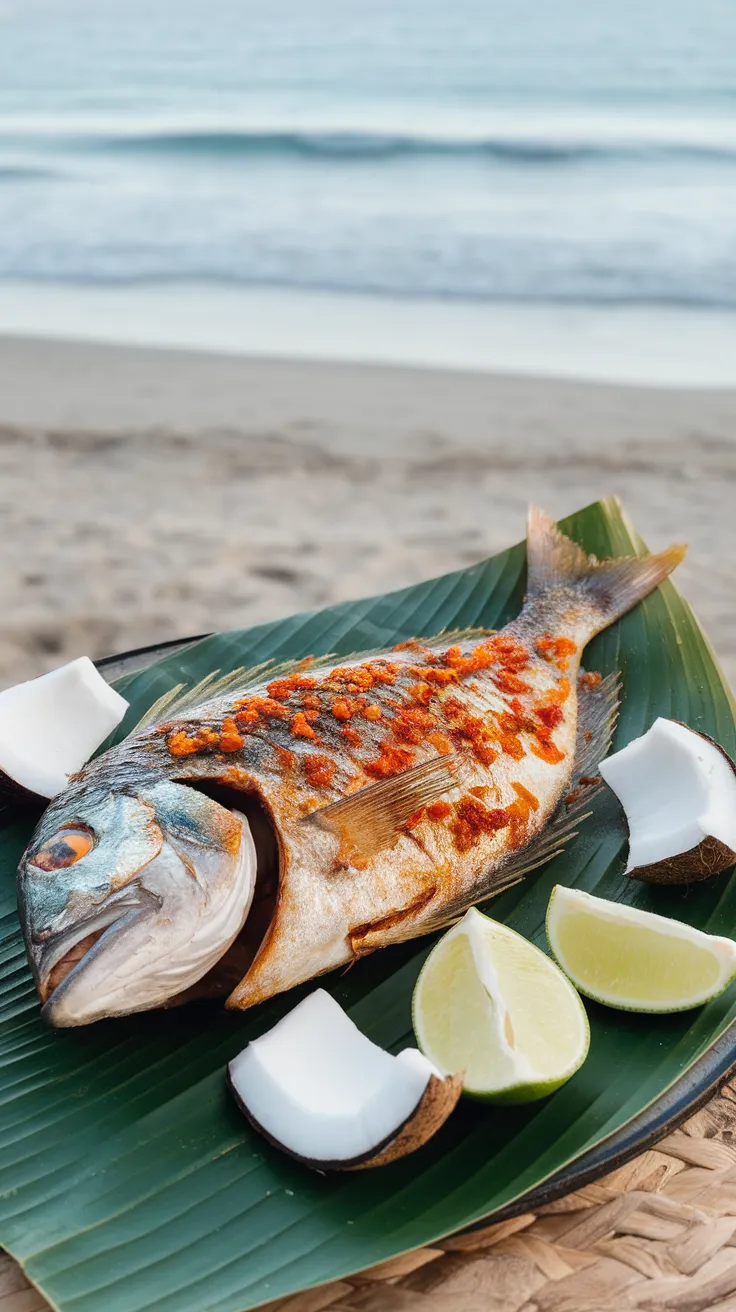Shorshe Ilish to Paturi: Why Hilsa is Bengal’s Fish of Festivals
Hilsa holds a special place in Bengali cuisine. It’s more than just a fish; it’s a symbol of celebration.
Known for its unique taste and aroma, Hilsa graces the tables during festive occasions across Bengal. Hilsa, or ‘Ilish’ as locals call it, is the star of many traditional dishes. Shorshe Ilish and Paturi are among the most cherished. These dishes bring families together, marking special occasions with their rich flavors.
Festivals in Bengal are incomplete without the presence of Hilsa. Its significance goes beyond taste. It represents heritage and cultural pride. Hilsa’s availability during the monsoon makes it even more special. This timing aligns with major Bengali festivals, adding to its festive importance. Dive into this cultural journey. Discover why Hilsa is not just food, but a festival icon in Bengal.
Cultural Significance Of Hilsa
Hilsa fish holds a special place in Bengali culture. Its delicate taste and rich flavor make it a favorite during festivals. Bengalis treasure hilsa for its unique cultural importance. It represents more than just a dish; it’s a symbol of tradition and identity.
Symbol Of Bengali Identity
Hilsa is not just a fish; it’s a part of Bengali identity. It connects Bengalis to their roots and traditions. This fish is often a highlight during family gatherings. Its presence on the table is a reminder of cultural heritage. Bengalis take pride in their culinary art, with hilsa often as the centerpiece. It embodies the spirit of the region and its people.
Hilsa In Traditional Celebrations
Hilsa is integral to Bengali celebrations. Festivals like Durga Puja see hilsa served in homes. It’s a staple in traditional feasts, symbolizing prosperity and joy. Families exchange hilsa as gifts, sharing love and happiness. The fish is prepared in various ways, each recipe cherished. From Shorshe Ilish to Paturi, each dish tells a story. These recipes pass down generations, preserving the culture.
Hilsa’s Unique Flavor
Hilsa, the cherished fish of Bengal, boasts a flavor unlike any other. Its distinct taste has become a staple in Bengali festivals, celebrated in dishes like Shorshe Ilish and Paturi. The unique flavor profile of Hilsa is a testament to its popularity and cultural significance.
Taste Profile And Texture
Hilsa’s taste is rich and slightly oily. It offers a delicate blend of sweetness and umami. The fish carries a mild tang, enhancing its flavor complexity. Its flesh is tender and flaky. This texture makes it a delight to eat. The fattiness adds depth to its taste, creating a mouth-watering experience.
Culinary Versatility
Hilsa adapts to various cooking styles. Whether steamed, grilled, or curried, it retains its unique flavor. Shorshe Ilish showcases Hilsa in mustard sauce, a Bengali favorite. In Paturi, the fish is wrapped in banana leaves, absorbing aromatic spices. These methods highlight its adaptability and cultural importance.
Shorshe Ilish: A Classic Dish
Shorshe Ilish, a classic Bengali dish, celebrates the rich flavors of mustard and Hilsa fish. This delicacy embodies the essence of Bengal’s festive spirit, with Hilsa being the star of occasions. From Shorshe Ilish to Paturi, Hilsa reigns supreme in Bengali celebrations.
Shorshe Ilish: A Classic Dish Shorshe Ilish, or Hilsa in Mustard Sauce, is not just a dish; it’s an emotion for Bengalis. This classic recipe celebrates the rich, flavorful Hilsa fish, often considered a culinary treasure in Bengal. The combination of mustard’s pungency and Hilsa’s unique taste creates a dish that stands out in any feast.
Ingredients And Preparation
Preparing Shorshe Ilish requires a handful of ingredients that are likely already in your kitchen. You’ll need Hilsa fish, mustard seeds, green chilies, turmeric, salt, and mustard oil. These ingredients work together to create an explosion of flavors that defines this dish. Start by soaking mustard seeds and green chilies in water, then grind them into a smooth paste.
Marinate the Hilsa pieces with turmeric and salt, then fry them lightly in mustard oil. Combine the mustard paste with water and pour it over the fish. Cook until the fish is tender, and you have a rich, aromatic sauce. The process might seem simple, yet each step holds a secret to unlocking the perfect balance of flavors. Have you ever wondered how such a minimalistic recipe can create such a profound taste?
Cultural Importance
Shorshe Ilish is more than just a meal; it is a cultural symbol of Bengali festivals and gatherings. During special occasions like Poila Boishakh (Bengali New Year) and Durga Puja, the dish takes center stage in family feasts. Eating Hilsa during these festivals is a tradition that connects generations, offering a taste of nostalgia and heritage. It evokes memories of family kitchens filled with laughter and the aroma of spices. Why do you think food plays such a significant role in cultural identity? In Bengal, the answer often lies in dishes like Shorshe Ilish, which bring people together and celebrate shared traditions. The love for Hilsa is not just about taste; it’s about preserving a piece of cultural history. As you savor each bite, you’re participating in a time-honored tradition that has been cherished for centuries.
Paturi: A Flavorful Delight
Paturi is a cherished Bengali dish. It celebrates the rich flavors of Hilsa. This delicacy wraps the fish in banana leaves. The result is a unique taste and aroma. Paturi is a beloved dish during festivals. Its preparation and presentation make it special.
Cooking Techniques
Cooking Paturi involves simple techniques. First, marinate the fish with spices. Mustard paste is essential for flavor. Wrap the marinated fish in banana leaves. Secure the wraps with a thread. Steam or grill the packages gently. This process infuses the fish with flavors. The leaves keep the fish moist and tender.
Regional Variations
Different regions have unique Paturi styles. In Kolkata, mustard paste dominates the flavor. Some regions prefer adding coconut paste. This adds a sweet touch to the dish. Certain areas use poppy seeds for richness. Each variation offers a distinct taste. These differences highlight the versatility of Hilsa.
Hilsa In Festivals
Hilsa, the shimmering silver fish, holds a revered place in Bengali culture. Its presence graces every festive occasion, elevating the culinary experience. Bengalis cherish Hilsa not just for its taste, but for the memories it creates. From traditional weddings to grand Durga Puja feasts, Hilsa is the star. Its rich flavor and cultural significance make it indispensable.
Role In Festive Menus
Hilsa is the hero in Bengali celebrations. It features prominently in dishes like Shorshe Ilish and Paturi. These recipes showcase its unique taste, loved by all. Families gather to enjoy Hilsa, sharing stories and laughter. The fish transforms meals into festive events. Its aroma fills the air, promising a delightful feast.
Every festival menu includes Hilsa dishes. They symbolize prosperity and joy. Hosts take pride in serving Hilsa, impressing guests with its flavors. The fish reflects the essence of Bengali hospitality. Hilsa dishes are often the highlight, anticipated eagerly by all.
Symbolism In Celebrations
Hilsa is more than just food. It embodies Bengali tradition and culture. During festivals, it represents abundance and happiness. Offering Hilsa is a gesture of goodwill and respect. The fish is a part of rituals and prayers, adding spiritual value.
Hilsa’s presence in celebrations is symbolic. It connects generations, preserving heritage through taste. Eating Hilsa is a cherished ritual, passed down through families. Its importance transcends food, becoming a cultural icon. Celebrating with Hilsa is a tribute to Bengali roots and values.
Hilsa Fishing Traditions
The Hilsa fish holds a special place in Bengali culture. Known as the “queen of fish,” its delicate flavors grace festive tables. The traditions surrounding Hilsa fishing are rich and deep. For generations, families have passed down skills and secrets. These traditions ensure the best catch each season. The methods and timing are crucial. They are key to maintaining the fish’s cultural significance.
Fishing Methods
Hilsa fishing methods are unique and time-honored. Fishermen use traditional nets called ‘jal.’ These nets are designed to catch Hilsa without harm. Skilled fishermen know the best locations in rivers and deltas. They often work in teams to maximize their catch. The process is both art and science. It requires patience and precision.
Seasonal Availability
Hilsa is a seasonal delight. Its availability peaks during the monsoon months. From June to September, the fish swims upstream to spawn. This is the best time for fishing. The abundance of Hilsa during this period is celebrated. Festivals and feasts are planned around its arrival. People eagerly await its return each year.
Economic Impact Of Hilsa
Hilsa, often heralded as the “queen of fish” in Bengal, goes beyond just a culinary delight. Its impact ripples through the economy, influencing various sectors and livelihoods. As you savor its taste, consider how its journey from river to plate supports entire communities.
Contribution To Local Economy
Hilsa fishing is more than a tradition; it’s a livelihood for thousands. Fishermen, traders, and vendors depend on its seasonal harvest for income. This economic activity fuels local markets, keeping the wheels of commerce turning.
The demand for Hilsa boosts local businesses. From boat makers to ice suppliers, the ripple effect is significant. How does your purchase impact these hidden facets of the economy?
Hilsa Trade Dynamics
Trade in Hilsa is a complex web of supply and demand. The fish’s popularity ensures a bustling marketplace, with prices fluctuating based on availability and quality. Are you aware of how this affects your wallet and the fisherman’s earnings?
International trade plays a role too. Hilsa exports bolster the economy, but strict regulations ensure sustainability. Your choices contribute to preserving this delicate balance.
Hilsa’s journey from river to your plate is a testament to the interconnectedness of our world. Next time you enjoy a Hilsa dish, think about the hands that brought it to you and the economic tapestry it weaves.
Challenges Facing Hilsa
Hilsa faces numerous challenges including overfishing and environmental changes, impacting its abundance. Despite this, Hilsa remains central to Bengal’s festivals, celebrated through traditional dishes like Shorshe Ilish and Paturi, highlighting its cultural significance.
Hilsa, the shining jewel of Bengal’s culinary tradition, faces challenges that threaten its reign as the fish of festivals. Despite its cultural significance, several factors are endangering this beloved fish. Let’s dive into the pressing issues and how they impact Hilsa, the pride of Bengali cuisine.
Environmental Concerns
Hilsa thrives in the brackish waters of rivers like the Ganges and the Padma. However, pollution from industrial waste and plastic is choking these habitats. These contaminants disrupt the delicate balance Hilsa needs to spawn and grow. Overfishing is another pressing issue. Hilsa is caught in large numbers, often before they can reproduce, diminishing their population. You might wonder how this affects you. Fewer fish mean higher prices and less availability for your favorite dishes. Climate change also plays a role. Rising temperatures and erratic weather patterns alter the river ecosystems. This can affect Hilsa’s migration patterns, making it harder for them to reach their breeding grounds.
Conservation Efforts
Efforts to conserve Hilsa are underway, with both government and community initiatives stepping up. Bans on fishing during breeding seasons help protect young Hilsa, allowing populations to recover. Communities are actively involved in conservation. Fisherfolk are being educated about sustainable practices, ensuring they can continue their livelihoods without depleting Hilsa stocks. These efforts can make a significant difference. What can you do to help? Support sustainable fishing practices by choosing Hilsa from verified sources. Advocate for clean river systems in your community. Every small action contributes to safeguarding Bengal’s fish of festivals for future generations.
Frequently Asked Questions
What Is The Importance Of Hilsa Fish In Bengal?
Hilsa fish holds cultural and culinary significance in Bengal. It’s celebrated in festivals and traditional dishes. Its rich taste and texture make it a delicacy. Hilsa also plays a role in regional identity and economy, being a prized catch during the monsoon season.
What Is The Cultural Significance Of Shorshe Ilish?
Shorshe Ilish holds cultural significance as a traditional Bengali dish, symbolizing heritage and celebration. It features hilsa fish in mustard sauce, enjoyed during festivals and special occasions. Its rich flavors and unique preparation connect Bengalis with their culinary roots, fostering a sense of identity and cultural pride.
What Is The Significance Of Fish In Bengal?
Fish is a staple in Bengali cuisine and culture, symbolizing prosperity and tradition. Bengalis celebrate with fish dishes during festivals and daily meals. It plays a crucial role in health, providing essential nutrients. The vibrant fish markets and diverse recipes highlight its cultural importance in Bengal.
What Makes Hilsa Fish So Special?
Hilsa fish is prized for its rich, buttery flavor and delicate texture. It is abundant in Omega-3 fatty acids. Its unique taste makes it a culinary delight, especially in South Asian cuisine. Hilsa is also celebrated for its cultural significance, often featured in traditional Bengali dishes and festive meals.
Conclusion
Hilsa holds a special place in Bengali celebrations. Its rich taste and cultural value make it a festival favorite. Dishes like Shorshe Ilish and Paturi showcase its unique flavor. Families gather to enjoy these traditional meals, strengthening bonds. Hilsa’s importance goes beyond taste; it’s a symbol of heritage.
Every bite tells a story of love and tradition. Its presence at festivals is a testament to its enduring legacy. A true delight for those who cherish Bengali culture. Celebrate with Hilsa, the heart of Bengal’s festive feasts. Enjoy the flavors and the memories it brings.






